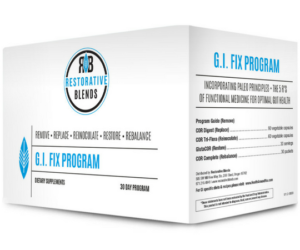
06 Dec Not Healing on a Gluten-Free Diet?
 Have YOUR symptoms failed to improve, even with a strict adherence to a gluten-free diet?
Have YOUR symptoms failed to improve, even with a strict adherence to a gluten-free diet?
Several studies have shown that simply going gluten-free is not always effective in treating the damage caused by years of inflammation and for actually healing the gut. Because so little emphasis is placed on the process of actually healing the gut after being diagnosed with Celiac Disease (or even non-gluten sensitivity), most will find that their chronic health conditions and symptoms fail to fully improve after transitioning to a gluten-free diet. We need to start addressing- Healing the Gut with Celiac Disease.
Does that mean that simply going gluten-free is the wrong prescription for healing your gut?
Logically, removing gluten is the first phase of treatment (which is why the Elimination Diet is the first step in the GI FIX Program). While removing the gluten is the most important step in beginning the healing process, this is rarely adequate for addressing the years of inflammatory damage leading to dysbiosis, intestinal permeability, and other health conditions.
The latest Celiac Disease research shows that a Gluten-free diet is just not enough when it comes to healing years of GI damage!
For the 1 in 133 US citizens with Celiac Disease (less than 10% actually diagnosed), studies show that most aren’t healing on a gluten-free diet alone. Even more profound is the current data showing that the inflammation and GI damage caused by Celiac Disease and other GI disorders actually increases ones risk of morbidity and mortality if not properly treated.
Intestinal Healing
The University of Chicago has one of the leading treatment and research centers for Celiac Disease in the US. They’ve stated that “While healing may take up to 2 years for many older adults, new research shows that the small intestines of up to 60% of adults never completely heal, especially when adherence to the diet is less than optimal.” [1]. 60% odds means that if you’ve been recently diagnosed with Celiac Disease after years of suffering from chronic symptoms, chances are simply removing the gluten won’t be enough to reverse the damage.
So does that mean that people just aren’t adhering to a 100% gluten-free diet? While this may be the case for some, a 2009 study shows that lack of adherence is not always the case. Only 8% of adult patients healed on a gluten-free diet… A 2009 study in The Journal of Alimentary Pharmacology and Therapeutics looked at 465 Celiac Disease patients and found only 8% of adult patients reached “histological normalization” after following a gluten-free diet for 16-months (meaning their gut tissue completely recovered to that of a healthy person). The authors of this study stated: “Complete normalization of duodenal lesions is exceptionally rare in adult coeliac patients despite adherence to GFD”. [2] While these subjects followed a strict gluten-free diet for 16-months, the vast majority didn’t experience GI healing.
The success rate of the conventional treatment for Celiac Disease isn’t working, and proof is in the research! Another 2010 study in the American Journal of Gastroenterology looked at 381 adults with biopsy-proven Celiac Disease. The authors found small intestine mucosal recovery occurred in only 34% of participants following a Gluten-Free diet for 2-years. They concluded: “Mucosal recovery was absent in a substantial portion of adults with CD after treatment with a GFD.”. [3]
Nutritional Deficiencies
A 2002 study in the of Alimentary Pharmacology and Therapeutics looked at the vitamin status of 30 adults with Celiac Disease showing “biopsy-proven remission,” after following a gluten-free diet for 8-12 years. They found that 56% had poor vitamin status, suggesting that proper nutrient uptake is not occurring. The study concluded that: “It is generally assumed that Celiac patients adhering to a strict gluten-free diet for years will consume a diet that is nutritionally adequate. This is supported by the demonstration of a normal bone mineral density up to 10 years of dietary treatment. Our results may indicate otherwise. We found signs indicative of a poor vitamin status in 56% of treated adult Celiac patients.”. [4]
Even after following the conventional Celiac prescription for 10 years, the above study shows that 56% still showed signs of poor nutrient uptake, meaning their digestive system still isn’t working like it’s designed to. That means after 10 years of being gluten-free, HALF of all Celiac patients are likely starving for the critical nutrients required for health and longevity. It’s no surprise that there is a 77X increased risk for lymphoma. [5]
Inflammation

A study in The Journal of Alimentary Pharmacology and Therapeutics found that when 465 Celiac Disease patients followed a strict gluten-free diet for a period of 16months, 65% still had “persistent intraepithelial lymphocytosis”. This is the medical term for “fire in the gut”.[6] This study shows that inflammation can fail to improve, even after 16-months on gluten-free diet. Why is that important? Gut inflammation is associated with a laundry list of health issues, including cancer, intestinal permeability and in overall morbidity and mortality; not to mention the fact that 80% of the immune system is in the GI tract! If the gut isn’t healthy, the rest of the body can’t reach optimal wellness.
As if the preceding data wasn’t enough to drive home the significance of this problem, a 2008 study in the Journal of Inflammation looked at 18 symptom-free Celiac Disease (SFCD) patients and found they still had elevated markers of gut inflammation even after 2 years on a gluten-free diet. The authors reported: “Faeces of both active CD and SFCD (symptom-free 1-2 years on a GFD) patients, representing an imbalanced microbiota, significantly increased TNF-alpha production and CD86 expression in PBMCs, while decreased IL-10 cytokine production and CD4 expression compared with control samples.”. [7] In another 2009 study from the American Journal of Gastroenterology, researchers looked at small intestine biopsies from 45 children with Celiac Disease and 18 clinical controls. The authors found an increased presence of T cells (an inflammatory marker) in well-treated CD patients: “The long-lasting presence of high frequencies of T cells in the epithelial compartment in well-treated CD indicates that the epithelium is stressed possibly because of constant attack.”. [8]
Leaky Gut
The gluten-free diet doesn’t fix intestinal permeability (leaky gut). Fixing leaky gut is absolutely essential to reversing the damage from Celiac Disease, however current studies are showing the current treatment protocols of simply following a gluten-free diet doesn’t always fix this condition. A 2008 study in the Brazilian Journal of Medical and Biological Research tested for leaky gut in 22 Celiac Disease patients who had followed a gluten-free diet for 1 year. They found these patients following a gluten-free diet still had significantly more intestinal permeability when compared to healthy controls eating gluten. The study concluded: “This means that, at some time, complete recovery of intestinal villous may not have occurred and an inflammatory process may have persisted.” [9]
As it turns out, when Celiac Disease patients follow a strict gluten-free diet, their zonulin levels do fall (which is good). But the research shows that they still have elevated levels of zonulin compared to non-Celiacs. And when the zonulin levels are still high… the Tight Junctions can’t restore normal function and the leaky gut remains.[10] Remarkably, it was found that Celiacs produce 30 times as much zonulin as non-Celiacs, even though the non-Celiacs were not eating gluten-free diets while the celiacs had been off gluten for two years! The same study also addressed Leaky Gut in Celiac patients following a gluten-free diet for more than two-years: Here they measured trans-epithelial electrical resistance (TEER) of intestinal tissue taken from gluten-free Celiacs and gluten-eating controls. TEER is an estimation of the permeability of the gut, where a lower value indicates a greater level of permeability. They found that tissues taken from controls who had been eating gluten had three-fold less leakiness compared to Celiacs who had been off gluten for over two years. This, again, suggests that something besides gluten may be contributing to leaky gut in people with Celiac Disease.
Increased Morbidity and Mortality
The bottom line with all of the above studies is that for most cases of Celiac Disease or non-Celiac gluten sensitivity, a gluten-free diet is simply not always enough to fully heal the damage caused by years of gluten exposure. When this damage isn’t effectively treated, gut inflammation, intestinal permeability, digestive issues, malabsorption and an array of other conditions are not addressed. It is vital to understand that the systems of the body are all intertwined and highly dependent on one another for optimal functioning. Thus, by failing to address the associated symptoms and conditions that so often accompany Celiac Disease (and most other gastrointestinal disorders for that matter) optimal wellness cannot be achieved, and (in most cases) a steady decline in health will be experienced.
One of the largest cohort studies on Celiac Disease patients and mortality published in the Journal of The American Medical Association found that:
Those with Celiac Disease (villous atrophy) had a 2.80-fold increased risk of death the first year after diagnosis and a 39% increased risk of death over the study period.
They also looked at people with intestinal inflammation and found:
Those with intestinal inflammation (and not villous atrophy) had a 4.66-fold increased risk of death the first year after diagnosis and a 72% increased risk of death over the study period. [11]
A 72% increased risk of death! In other words, if you’re a symptom-free Celiac and your still dealing with gut inflammation… your life expectancy is greatly reduced!
A 100% adherence to a gluten-free diet is the very first step in healing the damage caused by gluten. But- you can’t stop there. These are only a few of the several studies published in medical journals which shows us that using a gluten-free diet as the sole source of treatment doesn’t fix leaky gut, inflammation, or nutritional deficiencies. The bottom line is- the conventional treatment plan for Celiac Disease is not working. Removing gluten is only the first phase in the healing process. There needs to be more…There needs to be a larger focus on healing and restoring the gut.
5 R’s of Functional Medicine
The G.I. FIX program encompasses the 5 R’s of Functional Medicine by first addressing the dietary component by REMOVING problematic foods (Gluten). The next 4 steps include utilizing specific clinical-grade nutraceuticals to: REPLACE digestive enzymes that are essential for digestion, REINOCULATE the beneficial bacteria of the gut microbiota, RESTORE the integrity of the gastrointestinal lining, and REBALANCE the body’s immune and inflammatory responses. Gut health and function are the most important variables for when it comes to reducing the risk of infection, chronic disease, autoimmune conditions, and optimizing digestion and absorption to aid in living a long and healthy life.
The dietary component of G.I. FIX is based on Paleo Principles which encourage swapping inflammatory processed foods for the natural, whole foods that your body was genetically designed to function and thrive on.
For the first 21 Days of the program you will be avoiding ALL Dairy, Grains, and Legumes (including soy products) in factor of organic meats and poultry, vegetables, fruits, nuts, seeds and oils.
It’s time to change the odds for those diagnosed with Celiac Disease; Its time to begin the journey back to Optimal Wellness!




Sorry, the comment form is closed at this time.